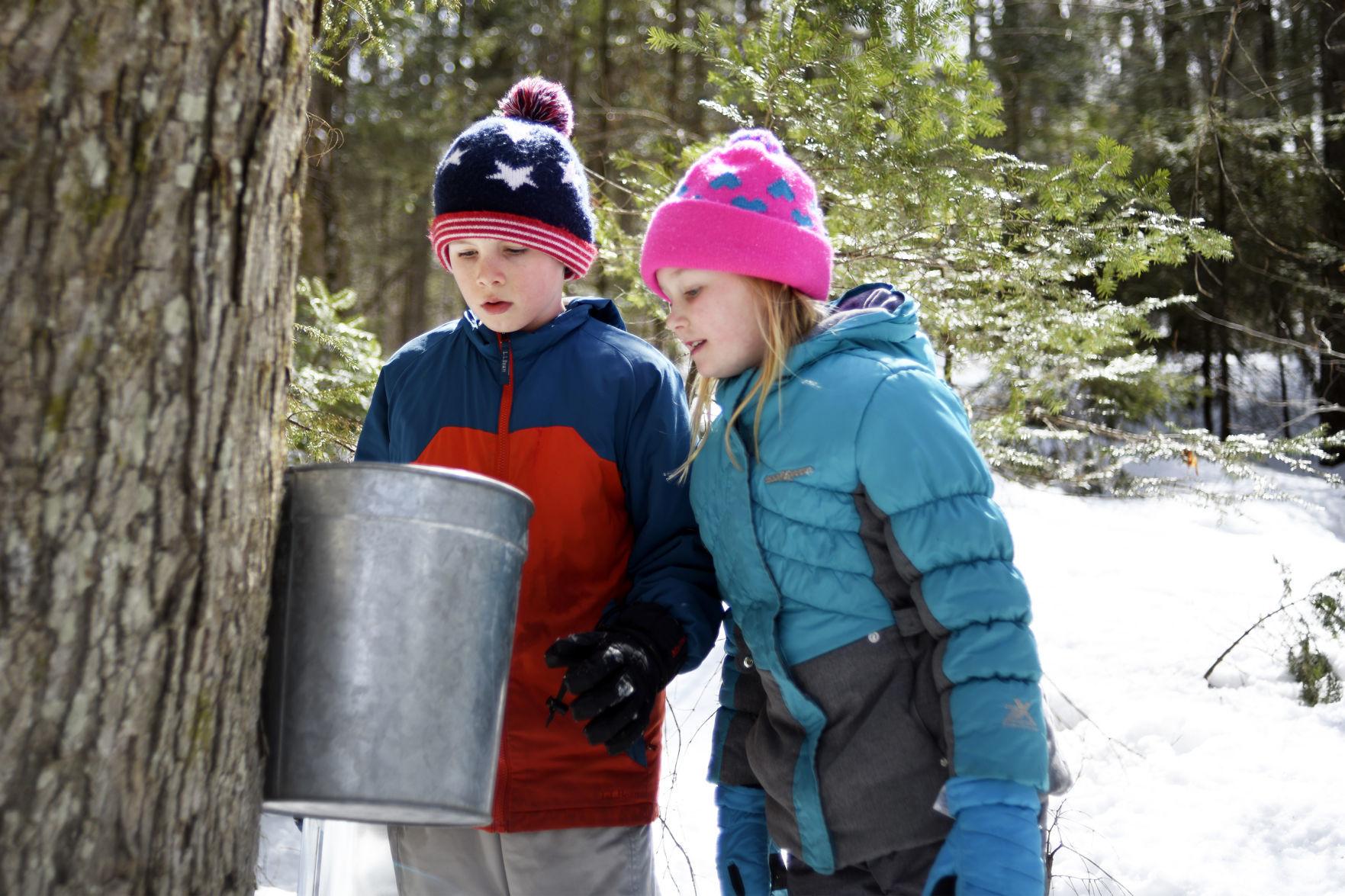Killington Elementary School
Rutland Herald
Friday, March 29, 2019

KILLINGTON
— Every year for the past 35 years, the fourth-grade classes at
Killington Elementary School wait anxiously for the lengthening daylight
and warmer temperatures, when the sweet sap of their maple trees begins
to flow.
It’s sugaring
season again, and local “sugar master” and former Killington School
Board chairman Steve Finneron can often be found at the school leading
groups of excited students over the brook and into the forest, where sap
lines are strung and buckets hang collecting the sweet water.
“It’s
part of the history of the state,” said fourth-grade teacher Shayna
Kalnitsky. “It’s an enormous part of the economy. ... There are families
in this school and community who depend on sugaring, on honey, on
farming for their livelihood.”
Finneron
started tapping the trees at KES when his daughter was in fourth grade
there, back when all the school had was a propane heater and a stock pot
for boiling.
“We put it on
cinder blocks and we put plywood around it, so the wind wouldn’t blow it
out,” Finneron said. “We only tapped two trees (back then) ... today,
we’ll have 21.”
Each of the
children taps one tree, and today it was Lucien Fleischner’s turn, and
his father, Hans, came along for his son’s big day.
“The
kids do (almost) everything,” Finneron said. “This year, we’ve had more
parents than we’ve had in a long time. ... Part of it has to do with
the jobs the parents have, and whether they can get away during the
day.”
Their sugaring season
begins in the fall, when Finneron takes the students out to their sap
lines in their forest to identify where sweet-toothed critters have
found stale sap and gnawed away at the tubing.
Repairing
the lines in the fall allow for more sap to flow through come late
winter, when the students and their parents haul a plastic garbage bin
out into the woods and bury it in the snow — leaving only the lid
uncovered — to serve as a naturally-refrigerated sap-collector where the
lines spill into.
“We usually start boiling when the trash can is half-way full or more,” Adelle Danilchik said.
“It’s like, a quarter-full right now,” said Leland Hall.
Every
year Finneron teaches the students how to use the power drill to punch a
hole in the trunk at an angle so the tap allows for gravity-fed sap to
run down into the bucket, how to clean out the hole with a twig and how
to gently tap the spout into the hole with a hammer so it doesn’t clog
up the opening.
“If we blow in
the hole (to clear it out) ... it blocks the sap from coming out,” said
Lillian Smith. “So if you scoop it out, it doesn’t block the hole.”
“Like scooping out ice cream,” said Adelle. “Except it’s tinier, and you have to be more precise.”
“And since we’re getting all the bacteria out, we don’t want to get more back in it,” Lillian added.
As
they approached their newest maple tree, Finneron asked the students
how they knew which trees to tap, and where to drive in the spout.
“The
tree regrows the wood,” Finneron explained of past tap-holes. “The
reason you can’t tap above or below it is, this line is now blocked.”
Taps
can be drilled horizontally next to the previous hole, as sap lines run
up and down the tree, but once one sap line in the tree is tapped, the
tree blocks it to protect itself, Finneron said.
Finneron
reached his arms around a tree, which Gallagher then identified as
being big enough for one tap as the bigger the tree is, the more sap it
would produce.
“A tree needs to
be 10 inches in diameter before you can tap it,” Finneron said. “Some
people tap smaller, but we don’t do that.”
Finneron
marked the depth on the drill they use with a piece of tape, so
students know when to stop drilling in the sap stream before they reach
the heart line, where there is no flow.
“The middle of every tree has a heart in the middle, and the sap flows outside,” Finneron said.
As
Lucien’s father helped deal the final, gentle blow to his son’s tap, a
gentle stream of sap drizzled from the spout, and into the bucket Lucien
bolted onto the top of the spigot.
“As the season goes along, the sap gets darker,” Finneron said. “When the sap turns yellow, you can’t make maple syrup anymore.”
After
tapping the 21st and final tree, Finneron led the students down out of
the woods to the sugar shack he helped build in 2002, the year after
teacher Maria Garland got a grant from the state.
Entering
the sugar shack was, for many of the students, an inaugural and sacred
moment: They gazed in awe at the inside walls covered in scrawled
signatures of the students who came before them, who boiled their
collected sap down for a big, collective pancake breakfast before
leaving their name in indelible ink.
As far as the students’ favorite ways to eat maple syrup, most said pancakes, but Lillian claimed a more diversified palate.
“Waffles,” she said. “With whipped cream. And syrup, and also strawberries.”
“I like the strawberries on the side, on a separate plate,” Adelle chimed in. “I like them cold. The pancakes make them hot.”
katelyn.barcellos
@rutlandherald.com

